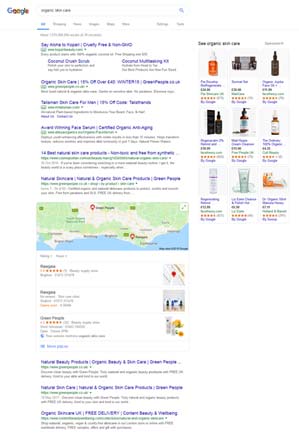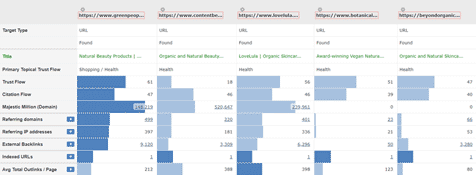Beauty and Skincare Digital Marketing Strategy Ideas
Natural skincare, organic skincare, we need a strategy
They say that beauty is only skin deep. So, it’s no wonder that skincare is so high on the agenda for so many of us. According to Market Research.com the global market for skincare, including natural moisturiser and organic moisturisers, is set to be worth $135 billion by 2021.
Instore, online and in my lady’s chamber.
According to Forbes, half the growth is online and half in store. Which is an ideal combination as we know that the two platforms support each other.
Start with the customer
We like to start with getting as clear an understanding of your customer as possible. What do they like? What are they like? What are the problems they want to solve when they look for the products you are selling? Once we’ve got that clear, we can roll our sleeves up and start to think about the words they will be using when they search for the products you are selling. Keyword research reveals the words consumers are using, not the words the industry thinks they should use.
But before we get into a couple of examples, how do you choose the words to research?
The right mix of keywords

Keywords fall into three categories according to how people are searching. There are simple, generic terms. Often just one or two words such as ‘skincare’ they are often used for research and have little ‘buying intent’.
Consideration terms are more sophisticated and will often be a generic term plus an adjective, for example ‘organic skincare’, ‘vegan skincare’ or ‘natural skincare’. These are searches by people who know roughly what they want.
The third category are buying search terms with a much more specific search query such as ‘organic tinted moisturiser, next day delivery’. There are less people searching but a greater proportion are looking for the buy now button.
As buying intent increases the number of searches decreases. So which path to follow? The trick is to mix them. You need some generic terms, some considered combinations, and a healthy dose of buying keywords.
| Keyword | Avg Monthly Searches | Page One Competition | Suggested Pay Per Click (PPC) Bid | Est Monthly Traffic | Est PPC Budget |
|---|---|---|---|---|---|
| skin care | 12,100 | High | £0.68 | 2,420 | £1,646 |
| best skin care products | 5,400 | High | £1.01 | 1,080 | £1,091 |
| vitamins for skin | 5,400 | High | £0.47 | 1,080 | £508 |
| best moisturizer for dry skin | 4,400 | High | £1.05 | 880 | £924 |
| korean skin care | 2,900 | High | £0.27 | 580 | £157 |
| natural skin care | 1,900 | High | £0.80 | 380 | £304 |
| skin care for men | 1,900 | High | £0.61 | 380 | £232 |
| best moisturizer for combination skin | 1,600 | High | £0.57 | 320 | £182 |
| best vitamins for skin | 1,300 | High | £0.56 | 260 | £146 |
| best skin care | 1,300 | High | £1.08 | 260 | £281 |
| mens skin care | 1,300 | High | £0.56 | 260 | £146 |
| korean skincare | 1,000 | High | £0.25 | 200 | £50 |
| organic skin care | 1,000 | High | £0.82 | 200 | £164 |
| natural skin care products | 880 | High | £0.71 | 176 | £125 |
| organic skincare | 720 | High | £0.77 | 144 | £111 |
| best face wash for oily skin | 720 | High | £0.82 | 144 | £118 |
| vegan skincare | 590 | High | £0.95 | 118 | £112 |
| japanese skin care | 390 | High | £0.21 | 78 | £16 |
| french skincare | 260 | High | £0.40 | 52 | £21 |
| organic tinted moisturizer | 70 | High | £0.42 | 14 | £6 |
| hemp skincare | 50 | High | £0.21 | 10 | £2 |
| probiotic moisturiser | 20 | High | £1.22 | 4 | £5 |
| salt skincare | 10 | High | £0.21 | 2 | £0 |
Strategic metadata – beware of the blog
Metadata is the most important place to use keywords that you want to be found for in search results. However, you need to take care over how you use your carefully researched keywords. Don’t go spraying them around your site like cheap perfume.
We often see the same keywords in the metadata for many pages on the same site. Google responds to that by either sharing the attention between them, so none of them rank usefully, or ignoring your most loved page completely.
You need a clear strategy to determine what goes where. Category pages are important, as are product pages. But beware blogs. It’s great to have a blog but optimising them with keywords which ought to be sending people to the products they are ready to buy is just daft.
The competitive landscape
Let’s imagine that you’ve found a keyword that lots of people are using to search for the very product you want them to buy from you. You’ve also thought about exactly where to use the keyword for the greatest impact on your sales. That’s good but it’s only a start. Part of your strategy to get your site to rank highly for your chosen search term needs to consider where you are now and who you need to compete with.

The first thing you notice is that the page is dominated by paid advertising - text based and shopping ads. We will talk about that soon.
In the meantime, lets focus on who is ranking highly. Our own research has shown that companies at the top of page one can get 98% of the clicks. That doesn’t leave much for the others.
Following an article in Cosmopolitan, Green People have the first two organic places with their the meta data ‘organic beauty and skincare’. Then there is a feature in the Independent followed by ss
And here they all are entered into Majestic, a piece of software which looks at how Google regards your site.

Trust flow, a score out of 100, tells you how Google regards your site. And 61 is a pretty good score. It’s made up of a number of factors but one of the most important is the number of ‘Referring Domains’ or, to put it another way, the number of websites which link to your website. With 499 Green People have twice as many as anyone else. But what are they? Here’s an extract from another chart, once again from Majestic.
| SourceTitle | AnchorText | SourceTrustFlow | Domain |
|---|---|---|---|
| eKomi | The Feedback Company | client website | 38 | ekomi.co.uk |
| Deodorant | Ethical Consumer | green people | 43 | ethicalconsumer.org |
| Discounts | Alumni and supporters | University of Exeter | green people | 38 | exeter.ac.uk |
| Best Beauty Advent Calendars 2018: From No7 to Elemis, Harrods, & MORE - Photo | green people | 39 | hellomagazine.com |
| Green People (greenpeopleuk) on Pinterest | www.greenpeople.co.uk | 37 | pinterest.com |
| Green People (@GreenPeopleUK) | Twitter | greenpeople.co.uk | 37 | twitter.com |
| Links | Organic Food Federation | www.greenpeople.co.uk | 39 | orgfoodfed.com |
| Beauty Advent Calendar 2018 - Best Makeup Advent Calendars for Christmas | green people | 30 | elle.com |
| Beat the Microbead | green people | 34 | beatthemicrobead.org |
These are the sorts of links you would need to be getting before you could compete with Green People. eKomi is a reviews / affiliates site, so that’s a commercial decision. Then there are a number of links which have been won from organisations like Exeter University, Organic Food Federation and ’Beat the Micro Bead’. A technique we use is to rank competitor’s links by Trust Flow and then go after the top 20% which are probably worth 80% of the Trust Flow value.
You should consider where you rank for your chosen keyword right now. If you are on page two and the competitors’ domain authority is within reach, then go for it. If you don’t rank at all and the gap in domain authority is in double digits, then it is time to find another term to compete on. It’s all about having a clear and considered strategy.
You need to research and analyse until you have the right keywords, which you can compete on, to drive the people who want to buy what you are selling to the right place on your site.
And maybe you should also consider Google Shopping.
Google Shopping
Back to that page of search results. You will remember that they are dominated by Ads. Some are text Ads, which means they appear at the top of the listings. Others are shopping Ads. And you will have noticed that some have a row of stars. Those are ratings or reviews. And if you ever wonder how important they are, then let me tell you, it’s very important.
Getting found in organic search results is very cost effective but it takes a while to kick in. When we are talking to potential clients, we warn them that while improving how they are found through Google and other search engines will add an average of 79% of revenue over the first year it may not kick in for up to six or seven months. When it does kick in it really kicks in. Paid advertising can have an immediate impact.
Is Google Shopping right for you?
It’s a simple set of questions.
- How many clicks will your budget buy?
- How many people who click on your ads will buy from you?
- How much will they spend?
- Is it worth it?
How many clicks will your budget buy?
From the keyword research we did earlier it’s possible to see that the average suggested click for ‘Organic Skincare’ would cost around £0.77p. The figure is only an estimate of the actual amount which is determined by a live auction. But for now we can estimate that for a spend of, say £2,000, you buy you 2,597 clicks. In other words
£2,000 (your budget) / £0.77 (Ave. cost per click) = 2,597 (number of clicks you are buying)
How many people who click on your ads will buy from you?
Let’s assume a conversion rate of 3%. We’ve got a separate blog about what’s a good ecommerce conversion rate but for now let’s stick with 3%. That means around one in every thirty-three site visitors is going to buy.
2,597 (number of clicks you have bought) / 3% (proportion of people who clicked that will buy) = 77 (The number of people who will buy from you)
How much will they spend?
We need to know your average order value. You can get the true figure from your Google Analytics, but we are going to assume you are selling a lot of organic skin care and that you have a free delivery offer nice and prominently displayed because you have taken note of research from WHO that 75% of people increase their spend to get free delivery. So let’s assume your average order to be £80.
77 (People buying) x £80 (The average amount they spend) = £6,160 (Your revenue from Google Shopping)
Is it worth it?
So that’s £6,160 revenue for a media spend of £2,000. A return on Ad Spend of 308% How good that is will depend on your profit margins and also how much the life time value of that new customer is worth to you. You can always use channels such as email marketing to encourage them to buy again. And you may want to think about ways of reducing the cost per click, improving your conversion rate and driving up your average order value.
There are other important things to know about Google Shopping. You must have a good, clean shopping feed to drive it. You risk a ban from Google if you end up advertising products you don’t have available to sell. We also recommend adding custom fields so that you can control what is being displayed and when. That way you can focus on profitable products that are most likely to sell.
Social Advertising with Facebook
We mentioned using email marketing to encourage customers to buy again. You can also use them as part of an effective social advertising campaign. To be clear, we’re talking about paid adverts that appear on, for example Facebook or Instagram to send people to buy from your website. We are not talking about boosting your social media presence or influencers.
Facebook Ads comes with the ability to upload your customers’ emails. You’ll then be able to advertise to them via Facebook. You can also advertise to their friends, who are likely to share the same interests, and to look-a-like audiences with similar characteristics. We’ve found that the most effective way of using look-a-like audiences is to expand the audience incrementally starting by adding a relatively small number of Facebook users with very similar characteristics rather than spreading the net too wide and diluting the similarity with your existing customers.
It’s then possible to overlay the audience of existing customers and look-a-likes with specified interests and then to show them customised advertisements. When you show people who are similar to your existing customers something you know they are interested in your chances of a sale are dramatically enhanced.

Just scratching the surface
If you are selling organic skincare, natural skincare or any other sort of skincare you will know just how important your online presence is. This blog is intended to encourage you to take a planned, strategic, joined up approach to digital marketing. I’ve tried to offer some thoughts about marketing strategies and tactics you can try yourself but if you would like to talk through the issues discussed don’t hesitate to get in touch.
